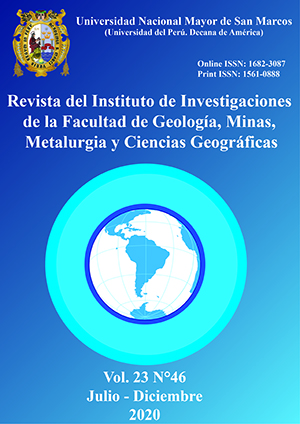Petromineralogy and hydrothermal alteration of the Limoncillo Vein South of Morro Solar, Lima, Peru
DOI:
https://doi.org/10.15381/iigeo.v23i46.19182Keywords:
Limoncillo vein, petromineralogic, infrared spectrometry, native gold, hydrothermal alterationAbstract
This research work consists of petromineralogical analysis and infrared spectrometry to determine mineralization and hydrothermal alterations in the Limoncillo vein. This structure is located in the quartz-arenites of the Marcavilca Member of the Morro Solar in Lima and is associated with a dike and a sinestral fault of N-S direction. The mineral of economic interest is represented by native gold scattered on the hydrothermal quartz of the vein and, in greater concentration, on the quartz arenites adjacent to the Limoncillo Vein. Using infrared spectrometry it was possible to determine two types of hydrothermal alteration: 1) Argillic alteration represented by the mineralogical association of kaolinite, illite-smectite and potassium illite, which suggest a formation temperature between 150 ° and 200 ° C and a pH moderately acid, with a tendency to neutralize; and 2) sub-propylitic alteration evidenced only by the Chabasite mineral species, which is typical of temperatures between 100 ° and 150 ° C and a neutral to alkaline pH.
Finally, the association of alteration minerals reflects a variation on the pH fluid (which is moderately acidic to neutral-alkaline), and allow define the temperature range of 200°C to 61°C, which indicates that the Limoncillo vein would be part of a system of epithermal veins.
Downloads
Published
Issue
Section
License
Copyright (c) 2020 Ánghelo Aníbal Baldoceda Dionisio, Franco Anderson Quispe Vidal, Wilson Humberto López Abanto

This work is licensed under a Creative Commons Attribution-NonCommercial-ShareAlike 4.0 International License.
AUTHORS RETAIN THEIR RIGHTS:
a. Authors retain their trade mark rights and patent, and also on any process or procedure described in the article.
b. Authors retain their right to share, copy, distribute, perform and publicly communicate their article (eg, to place their article in an institutional repository or publish it in a book), with an acknowledgment of its initial publication in the Rev. Inst. investig. Fac. minas metal cienc. geogr.
c. Authors retain theirs right to make a subsequent publication of their work, to use the article or any part thereof (eg a compilation of his papers, lecture notes, thesis, or a book), always indicating the source of publication (the originator of the work, journal, volume, number and date).






